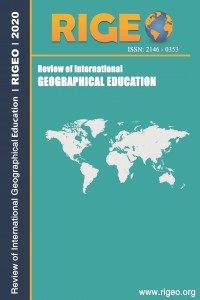Integrating Geography Skills in the Middle Grades: Instructional Change in South Carolina, USA
Integrating Geography Skills in the Middle Grades: Instructional Change in South Carolina, USA
In 2019, the State of South Carolina (USA) adopted new social studies standards with an emphasis on disciplinary skills in addition to content throughout the social studies areas of history, geography, civics, and economics. These skills were introduced for all grades, kindergarten through grade 12. Geography courses were added in grades 3 and 7. The standards specify and deconstruct six geography skills to be taught in these classrooms. These skills include Mapping; Models and Representations; Gather Evidence and Communicate Findings; Conditions, Connections, and Regions; Scale; and Distribution and Pattern. Social studies coordinators at the school district level were interviewed on the successes and obstacles teachers are experiencing, and on what future actions were being considered to address these skills in teaching
Keywords:
geography skills academic standards, middle level students,
___
- Bednarz, S. (2003). Nine Years On: Examining Implementation of the National Geography Standards. Journal of Geography, 102(3): 99-109.
- Catling, S. (2004). An understanding of geography: The perspectives of English primary trainee teachers. GeoJournal, 60(2): 149–158.
- Chapin, J. (2007). A Practical Guide to Middle and Secondary Social Studies. 2nd ed. New York: Pearson.
- De Souza, A. & Munroe, S. (1994). Implementation of Geography Standards: Potential Strategies and Initiatives. Journal of Geography, 93(1): 46-49.
- Geography Education Standards Project. (1994). Geography for Life. Washington D. C.: National Council for Geographic Education.
- Gersmehl, P. (2014). Teaching Geography. New York: Guilford.
- Heffron, S. (2012). GFL2! The Updated Geography for Life: National Geography Standards, Second Edition. The Geography Teacher, 9(2), 43-48.
- Heffron, S. & Downs, R. (eds.). (2012). Geography for life: national geography standards. Washington, D. C.: National Council for Geographic Education.
- Höhnle, S., Fögele, J., Rainer Mehren, R., & Schubert, J. (2016). GIS Teacher Training: Empirically-Based Indicators of Effectiveness. Journal of Geography, 115(1), 12-23.
- Lee, J. & Butt, G. (2014). The reform of national geography standards in South Korea – trends, challenges and responses. International Research in Geographical and Environmental Education, 23(1): 13-24.
- Lesh, B. (2017). “Why Won’t You Just Tell Us the Answer?” Teaching Historical Thinking Skills in Grades 7-12. Cheltenham, Victoria, Australia: Hawker Brownlow Education.
- Maude, A. (2014). Developing a national geography curriculum for Australia. International Research in Geographical and Environmental Education, 23(1): 40-52.
- Mitchell, D. (2016). Geography teachers and curriculum making in “changing times.” International Research in Geographical and Environmental Education, 25(2): 121-133.
- Mitchell, J. T. (2018). Pre-Service Teachers Learn to Teach Geography: A Suggested Course Model. Journal of Geography in Higher Education, 42(2), 238-260.
- National Council for the Social Studies (NCSS). (2013). The College, Career, and Civic Life (C3) Framework for Social Studies State Standards: Guidance for Enhancing the Rigor of K-12 Civics, Economics, Geography, and History. Silver Spring, Maryland: NCSS.
- South Carolina Department of Education (SCDE). (2019). South Carolina Social Studies College- and Career-Ready Standards. Columbia, South Carolina: SCDE.
- South Carolina Education Oversight Committee (SCEOC). (2016). SC Social Studies Academic Standards Cyclical Review Report. Columbia, South Carolina: SCEOC.
- Spurná, M., Knecht, P. & Svobodová, H. (2020). Perspectives on geography education in the Czech National Curriculum. International Research in Geographical and Environmental Education, DOI: 10.1080/10382046.2020.1789807.
- Wineburg, S. (2018). Why Learn History (When It’s Already on Your Phone). University of Chicago.
- ISSN: 2146-0353
- Başlangıç: 2011
- Yayıncı: Eyüp ARTVİNLİ
Sayıdaki Diğer Makaleler
How Geogames Can Support Geographical Education?
Elçin AYAZ, Okan DORUK, Rabia SARIKAYA
Raziya KALDYBEKOVA, Bülent AKSOY, Bahadurkhan ABDYMANAPOV
Skill of Location Analysis in Social Studies Curriculum and Textbooks of Turkey
Integrating Geography Skills in the Middle Grades: Instructional Change in South Carolina, USA
James MEWBORNE, Jerry MİTCHELL
A Mixed-Design Study on Development of Spatial Perception Skills in Life Science Course
Nur ÜTKÜR GÜLLÜHAN, Tuğçe EMRAL
A Study on Environmental Literacy Levels of Social Studies Teacher Candidates
Place of Observation Skill in 5th Grade Social Studies Textbooks
